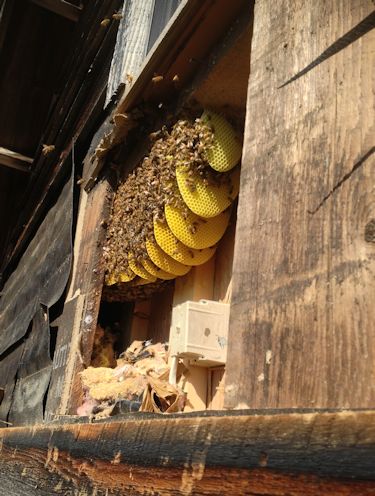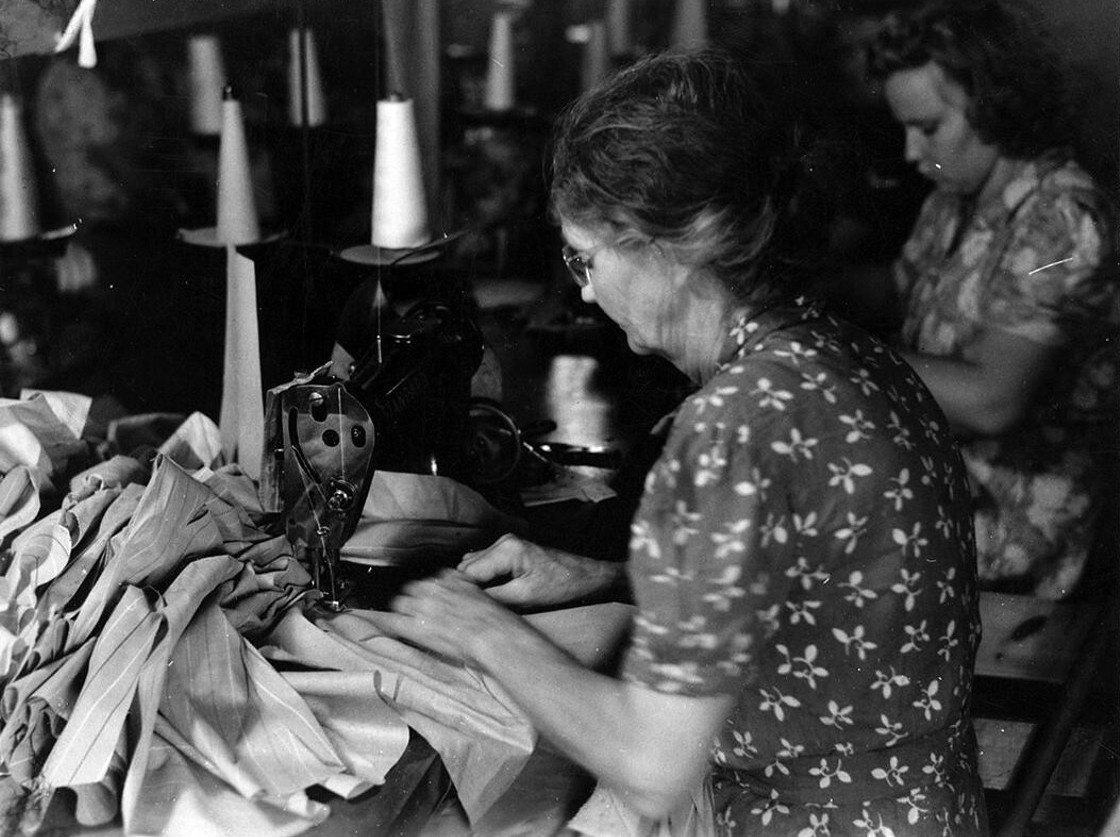Honeybee FactsFrom Backyard Beekeepers’ Association Bee BytesHoneybees are not native to the United States. They are European in origin, and were brought to North America by the early settlers. Supporter SpotlightHoneybees are not aggressive by nature and will not sting unless protecting their hive from an intruder or are unduly provoked. Honeybees represent a highly organized society, with various bees having very specific roles during their lifetime: nurses, guards, grocers, housekeepers, construction workers, royal attendants, undertakers, foragers, etc. The queen bee can live for several years. Worker bees live for six weeks during the busy summer and for 4-9 months during the winter. The practice of honey collection and beekeeping dates back to the stone age, as evidenced by cave paintings. The honeybee hive is perennial. Although quite inactive during the winter, the honeybee survives the winter months by clustering for warmth. By self-regulating the internal temperature of the cluster, the bees maintain 93 degrees in the center of the winter cluster regardless of the outside temperature. Supporter SpotlightBee SocietyQueen Bee: There is only one queen per hive. The queen is the only bee with fully developed ovaries. She can live for 3-5 years but mates only once with several male, or drone, bees. The queen lays up to 2,000 eggs a day. Fertilized eggs become female, or worker bees, and unfertilized eggs become male, or drone bees. When she dies or becomes unproductive, the other bees will “make” a new queen by selecting a young larva and feeding it a diet of “royal jelly.” Worker Bee: All worker bees are female, but they are not able to reproduce. Nearly all of the bees in a hive are worker bees. A hive consists of 20,000-30,000 bees in the winter and over 60,000 in the summer. The worker bees sequentially take on a series of specific chores during their lifetime: housekeeper; nursemaid; construction worker; grocer; undertaker; guard; and finally, after 21 days they become a forager collecting pollen and nectar. The worker bee has a barbed stinger that results in her death following stinging, therefore, she can only sting once. Drone Bee: These male bees are kept on standby during the summer for mating with a virgin queen. Because the drone has a barbed sex organ, mating is followed by death of the drone. There are only 300-3,000 drones in a hive. The drone does not have a stinger. Because they are of no use in the winter, drones are expelled from the hive in the autumn. |
MANTEO — Fountain Odom doesn’t belabor the metaphor, but he does seem to appreciate the workings of democracy with honeybees more so than those of his former colleagues in the N.C. General Assembly.
As a veteran beekeeper, Odom, who served 14 years in the state senate, speaks in awe of the efficiency of the hive, its remarkable skill in communicating and cooperating and the dedication and loyalty of its workers.
“They swarm sometimes because the old queen has started to slow down,” he explained during a recent interview on the back porch at his elegant vintage house in Manteo. “They decide it’s time to start a new home. But before they swarm and leave, they actually send scouts out to find another home.”
Then the hive conducts a bee-version of a debate on the merits of each scout’s finding and holds a yay-or-nay vote before agreeing to relocate.
 Fountain Odom and his wife, Carmen. |
Then all 40,000 to 80,000 of the hive’s bees swarm together to the new locale, and proceed with business. Sure, sometimes it’s someone’s condo or even an airplane cockpit, but it’ll be home until a beekeeper gently persuades them to move into a nice bee box.
“I do not believe that there is any creature that God has put on the face of the Earth that is more admirably beneficial or interesting than the honey bee,” Odom said, as he looked into his verdant backyard , landscaped to provide privacy and a blooming and blossoming Eden-like setting.
Even in his semi-retirement, Odom has kept his hands in the hive, so to speak, of both bees and politics. In recent months, he has helped found a new chapter of the N.C. Beekeepers’ Association on the Outer Banks. He put himself at risk of getting stung by different kinds of venom with his election in April as chairman of the Dare County Democratic Party.
And he still maintains his law practice in Manteo and Charlotte.
With an upbeat demeanor and lively vivid blue eyes, Odom, 76, says he got interested in bees 45 years ago when he and his late wife, Jane – to whom he was married 39 years – started playing bridge with some couples in their Charlotte neighborhood. One of the men was a beekeeper, and Odom was intrigued by his stories about his bees.
Before long, Odom had his own hives and had learned the art of harvesting honey and relocating swarming bees. Along the way, his brother Jimmy got involved, and between the two of them, they’ve taken care of 15 to 25 hives. He was recently awarded Beekeeper of the Year by the state association.
And 12 years ago, Odom married Carmen Hooker, the former director of the state health department.
But a lot has changed for the bees in the decades since Odom has been beekeeping. For one thing, there are less of them.
Odom says he remembers avoiding patches of clover when he was a boy. “You did not run through it because it would be full of bees,” he says. “Today, you won’t find that. Almost all of the feral bees are gone.”
Scientists have warned for years that pollinators such as honey bees and their cousin bumblebees are not thriving. In some places, massive deaths of entire hives, known as “colony collapse,” is causing alarm.
Worldwide, about one-third of honeybee hives collapse, according to a July 14 article by Mark Winston in The New York Times. Winston, a biologist at Simon Fraser University in Vancouver, blamed a synergy of numerous pesticides and various pests and diseases as well as nutritional deficits caused by the lack of diverse pollinating flowers in single crop farmlands.
Residue from more than 120 pesticides, the article said, can be found in a typical colony. “Alone, each represents a benign dose,” Winston wrote. “But together they form a toxic soup of chemicals whose interplay can substantially reduce the effectiveness of bees’ immune systems, making them more susceptible to diseases.”
One widely-used pesticide, neonicotinoid, is often named as a main culprit. But even if it was eliminated, it is not going to solve the problem, said Adolphus Leonard, apiary inspector with the N.C. Department of Agriculture and Consumer Services in the northeastern counties of the state.
Leonard, a former commercial beekeeper who now keeps about a dozen hives as a hobbyist, said that “neonics” replaced worse pesticides, and if they were banned, farmers would likely have to revert to more toxic pesticides. And from what he has seen as an inspector, a mite native to Asian bees has caused more trouble by shortening the lifespan of the bees and weakening the colony.
There are still a lot of questions that need to be answered on what is going on with the bees. “We’ve had less pesticide bee kills in the last 10 years than we’ve ever had before,” Leonard said. “My cautionary tale is: Don’t get ahead of the science.”
In his observation, Leonard said the spate of “catastrophic cases” a few years ago is becoming less common. “The bees in North Carolina look better than they have in the past,” he said.
North Carolina bees are shipped to California to pollinate almond trees, Leonard said. When they’re done, they may be brought to another state, or returned to North Carolina, to do their thing with another crop.
Wild plants, including trees, provide more diverse pollen, and consequently, healthier bees, than mono-culture agricultural fields. For that reason, Leonard said, North Carolina, with its large amount of wild areas, is a good state for honeybees.
But there are still challenges.
 Fountain Odom and his brother found this hive in the walls of the family cabin in Avery County in the state’s mountains. Photo courtesy of Fountain Odom. |
Of 2,212 colonies reported in a 2013 survey by the Bee Informed Partnership of bees in the state, about 35 percent were lost in the winter, according to results posted on the web site of the N.C. Beekeepers’ Association.
That’s not great, but it’s an improvement, said David Tarpy, professor of entomology at N.C. State University and extension apiculturist. “We say we’ve gone from horrible to bad,” he said. “We still have a ways to go until the bee hive populations are sustainable.”
Tarpy, who runs a bee research lab at the university, said that North Carolina has about 15,000 beekeepers – nearly all hobbyists. That’s the highest number of beekeepers per capita in the country.
As the president of the Outer Banks Beekeepers’ Guild, founded in February, Denise Deacon said she believes it is important for people to appreciate the value of honeybees in pollinating plants. Without them, the food supply would crash and there would be far fewer flowers and trees.
Deacon has three hives in her sunny front yard in Kitty Hawk, where she enjoys watching the bees do their magic on summer days. “They like heat – the inside of the hive is 95 degrees,” she said.
Since Deacon is still new to bees – this is only her third year as a beekeeper – she has not yet harvested honey from the hives. Her first two hives were lost to mites, and the next year, one hive was lost to wax moths. Those losses are part of the reason she reached out to other beekeepers in the area, including Odom.
“He’s been just an enormous help in getting us going,” Deacon said. “He’s been a great resource. He was very enthusiastic.”
There are already 26 members on the Outer Banks, she said, and even more on their e-mail list.
With help from Leonard and other beekeepers like Odom, Deacon said she is getting the hang of the art.
“The more I learn, the more astounded I am,” Deacon said. “I know there are people who are deathly afraid of any stinging creature. But honeybees are not aggressive. They defend their hive if they need to, but they’re such sweet little creatures.”
Bee colonies are 90 percent female worker bees, with a queen and a few drones – whose only job is to mate with the queen. In the winter, they survive by clustering together in a huge ball to keep warm.
But their combs are a work of art, Odom said, pulling out his cell phone to show a picture of them inside an exterior wall of his family’s Avery County cabin.
“It’s the most beautiful yellow wax comb,” he said, pointing to the rows of honey combs installed by the bees. “Those cells are all absolutely perfect. They’re hexagons.”
After Odom had a serious bout with cancer more than 20 years ago, he became much more open to alternative health remedies and healthy living in general. He is convinced pesticides are at the root of bees’ problems.
“It’s the chemicals that are being sprayed across the state,” he said. “You think about it – 50 years ago there was not colony collapse. There were wild bees and there was absolutely no spraying.”
Odom is impressed by the health benefits of bee propolis, a potent antioxidant from the wax, and bee venom therapy.
By prompting a bee to sting a problem area, he explained, the venom can spur the body to create its own form of cortisone. Odom said the therapy cured him of severe arthritis in his ankle and knee. He is so convinced it works, he took a course in Chicago to learn more about the therapy.
And of course, there’s the honey. When it’s the right time, Odom will travel to Charlotte and help his brother scrape the honey from the wax combs in the hives and filter it into jars. The taste is exquisite, he said, nothing like store-bought, which is often diluted.
Odom said he has been cancer-free and healthy for years, and the bees are helping him to stay that way.
“I don’t take any prescription medication,” he said. “I have a wife seven years younger. I chase her – and sometimes I catch her.”







